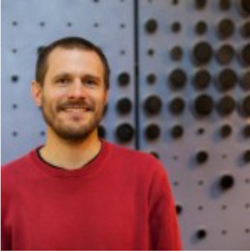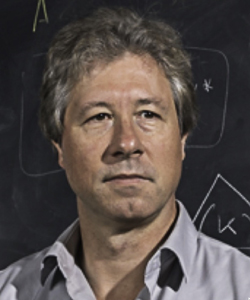
Eric A. Bergshoeff (Groningen University)
website: www.ericbergshoeff.nl
Eric Bergshoeff is a Full Professor in Theoretical High-Energy Physics at the University of Groningen. Since 2009 he occupies the ‘Willem de Sitter’ Chair in Theoretical Physics and in 2010 he was awarded an Academy Professorship by the Royal Netherlands Academy of Sciences. He received his PhD from Leiden University in 1983 and did postdoctoral work at Brandeis University, the ICTP and CERN.
Bergshoeff’s research has focused on supergravity, string theory and branes. He was one of the inventors, together with Sezgin and Townsend, of the eleven-dimensional supermembrane in 1986. More recently, in 2009, he introduced, together with Hohm and Townsend, a new ghost-free model of massive gravity in three dimensions that is called New Massive Gravity. His most recent research interest is related to the role of Newton-Cartan geometry in holography and condensed matter.

Jan de Boer (University of Amsterdam)
Jan de Boer (PhD Utrecht ’93) is a professor at the University of Amsterdam. He has broad interests in theoretical physics, ranging from mathematical physics to condensed matter physics, but with an emphasis on string theory, quantum gravity, black holes, and the gauge/gravity correspondence.
Recently, he has been particularly interested in applying ideas from quantum information theory to the reconstruction of space-time, introducing new concepts such as entwinement and differential entropy.

Alejandra Castro (University of Amsterdam)
website: staff.fnwi.uva.nl/a.castroanich
Alejandra Castro is an Associate Professor in the Institute of Theoretical Physics (ITFA) at UvA. In 2009 she received her PhD from the University of Michigan, and did postdoctoral work at McGill University and Harvard University.
Castro’s research focus is on classical and quantum gravity. Explaining the microscopic origin of black hole thermodynamics is an important aspect of her work, and tied to it is the emergence of classical spacetime in quantum gravity. On larger scales, understanding the metastability of an inflationary universe and cosmological singularities is another facet of her research. Her strategy is to craft and study low dimensional models of holography that are manageable but still preserve key features of general relativity.

Miranda Cheng (University of Amsterdam)
The research of Miranda Cheng focuses on the interaction between String Theory and Mathematics. She is particularly interested in quantum gravity, number theory, representation theory, topological string theory, and more.

Ben Freivogel (University of Amsterdam)
Ben Freivogel works on understanding what string theory has to tell us about black holes and cosmology, with a particular interest in situations where quantum gravity effects extend to long distances and low energies. He did his PhD with Leonard Susskind at Stanford University and postdoctoral work with Raphael Bousso at UC Berkeley and at MIT before coming to Amsterdam in 2012.

Umut Gursoy (Utrecht University)
website: http://web.science.uu.nl/ITF/People/staff/Gürsoy.htm
Umut Gursoy is an associate professor at the Institute of Theoretical Physics in Utrecht University. After obtaining his PhD at MIT in 2005, he has held postdoctoral positions at Ecole Normal Superieure/Ecole Polytechnique, Utrecht university and CERN. He is currently a recipient of the VIDI grant. His research interests range between applications of string theory, in particular the gauge/gravity duality to strongly interacting quantum field theories that arise in particle physics, and condensed matter physics to more formal aspects of string theory.

Diego Hofman (University of Amsterdam)
Diego Hofman is an Associate Professor at the University of Amsterdam (UvA) doing research in theoretical high energy physics with focus on String Theory, Holography and formal and applied aspects of Quantum Field Theory. Before his current position he held postdoctoral positions at Stanford and Harvard Universities. He obtained his PhD in Physics at Princeton University and undergraduate degrees from University of Buenos Aires (UBA) and Universidad de San Andres (UdeSA). He is currently the recipient of an ERC Starting Grant.

Kyriakos Papadodimas (University of Groningen & CERN)
Kyriakos Papadodimas is a staff member at the Theory Department of CERN and a faculty member at the University of Groningen. He received his PhD in 2006 from Harvard and has held postdoctoral appointments at the University of Amsterdam and CERN. He is interested in the fundamental principles of quantum gravity, string theory and non-perturbative quantum field theory. He has been working on exploring the emergence of spacetime in the framework of the AdS/CFT correspondence, with the ultimate aim of evantually understanding the quantum nature of more general spacetimes. His recent work has focused on developing a holographic description of the black hole interior and exploring the implications for the black hole information paradox. His investigations have uncovered interesting connections between quantum information, the limitations of locality and aspects of thermalization in strongly coupled systems.

Koenraad Schalm (Leiden University)
website: http://www.lorentz.leidenuniv.nl/~kschalm/
Koenraad Schalm (PhD’99 SUNY Stony Brook) is Professor of Theoretical Physics at the Institute-Lorentz for Theoretical Physics, Leiden University. He is the recipient of two Innovative Research Incentive Awards of the Netherlands Organization for Scientific Research.
Schalm’s research focuses on how string theory may be detected in laboratory experiments or cosmological observations. He is one of the pioneers of using holography to explain condensed matter challenges, a field where decisive experiments are expected to take place in the next decade.

Stefan Vandoren (Utrecht University)
website: http://web.science.uu.nl/ITF/People/staff/Vandoren.htm
Theoretical physicist Prof. dr. Stefan Vandoren is full professor at the University of Utrecht. His research concerns string theory, supergravity and black holes. He received his PhD at the University of Leuven in 1995, and did postdoctoral work at the University of Wales, Swansea, and at the State University of New York, Stony Brook. In 2008 he won the Descartes-Huygens prize for his work on string theory. In 2010 he was awarded an NWO-Vici grant. Together with Gerard ’t Hooft, he wrote a popular science book “Time in Powers of Ten”, about natural phenomena and their time scales.

Erik Verlinde (University of Amsterdam)
Erik Verlinde is Professor of Theoretical Physics at the University of Amsterdam. He is known for the Verlinde formula in 2d conformal field theory, a co-inventor of the WDVV equations and for his work on the entropic origin of gravity.
He is the recipient of an Advanced ERC grant (on the subject of emergent gravity) and in 2011 he was awarded the Spinoza Prize.
His research focusses on topics in mathematical physics, string theory, black hole physics (state counting, information paradox) and cosmology (in particular de Sitter space).
His most recent research interest is the link between quantum information and the emergence of spacetime and gravity. A specific goal is to understand the connection of these novel methods with known D-brane techniques.

Jan Zaanen (Leiden University)
website: www.lorentz.leidenuniv.nl/zaanen/wordpress/
Jan Zaanen is a Full Professor in Theoretical Physics at Leiden University since 2000. He received his PhD from Groningen University in 1986. He was awarded with the Dutch Spinoza prize in 2006 and he is member of the Royal Netherlands Academy of Sciences.
He is a condensed matter theorist by training and career, well known for the ZSA classification of strongly correlated insulators, the LDA+U band structure method, his prediction of electronic stripes, and his contributions to quantum criticality. Since 2007 he has been focused on the applications of AdS/CFT to condensed matter systems, particularly at the interface with quantum information theory.